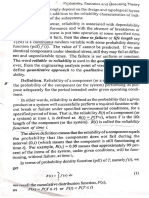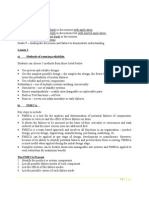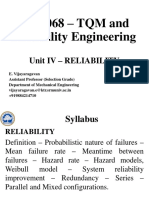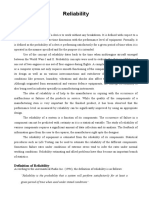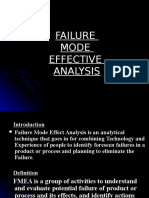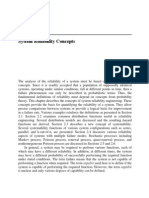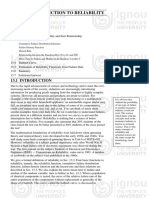0 ratings0% found this document useful (0 votes) 29 views8 pagesBasic Concepts of Reliability
Copyright
© © All Rights Reserved
We take content rights seriously. If you suspect this is your content,
claim it here.
Available Formats
Download as PDF or read online on Scribd
Definitions
@
“iy
iy
ww
o
w
(wi
itt)
ww
w
em < An item of an eatty is defined as» functional or structural wait Like »
‘component, device, equipment ora system which can be considered individually and
‘may include hardware ad or software and human resources.
[Lifetime : The time taken by any aoa-tepairable iter in its faire from the stat ofits
‘nit operation.
‘Fault: this isthe state of an item when it is unable o perform its required function
{ve to some reasons other than preventive maustenance work or some other planned
‘actions Fault can be a defector failure.
Defect : This is like nonconformity of a requirement in an item which is related to its
intended purpose. Defects occur due to some errors committed during design o¢
production process. &
System : It is consisting of assemblies, subsystems, components along with skills
‘and techniques which can he operated independently All of these tangible and
intangible entities interact with each other to perform a set of required functions by a
sytem.
Fenctional Block: It may be a simple component or a subassembly of components oF
‘a lacge subsystem as parts of system. Any functional block is said to be failed if itis
‘or able to perform its required function. The functions and performance criterion of
‘these functions for each element of the system is always predefined. The poteatial
failure modes ofthese functional block and their effect on the system is determined.
Fauetional Block Diagramy It is used to represent the structure ofthe system.
Systematic Failure : These failures are also called dynamic defect which are
8) where F(0) = Land Fo) =0
This Is aso galled the survival function of the reHabiMIy fuRcHON sinEE I gives the
probability of survival ofthe item up toa particular time and is denoted by R(t) hence
[rome�Hence Reliability isthe characteristic of an item or an equipment which define its ability to
perform its function successfully without any interruption. It is always represeuted in
‘probability terms
Definition (Reliability: It is defined by the probability that any item or equipment will,
perform its specified task for which it is specifically desiened . under stated conditions
for stated interval of time without any failure.
The concept of Reliahility can he applied to any process or service also. The failine ofan item
‘occurs when it is aot able to perform its required Rinction. Initially when an item stats
‘operating, itis considered to be free from any defect or systematic failure. Failures may de
classified by mode of failure which is symptom of observing the failure like cracking of
‘components. or by cause of failure (which may be intrinsic in nature and occur due to weakness
‘or wear out of the item or it may be extrinsic in nature which may occur due to any mistake
‘committed during designing , production or operating phase). Failure may also dus w physical
+ Chemical or any other process. Failures may be sudden and are called catastrophic failure or
it may be gradual and is called degradation failure,
Reliability can be measured quantitatively for a non-repairable system where itis calculated
tll the time ofits first failure or repairable system
Definitions:
Fault mode and effect analysis : (FMEA) —This isthe qualitative method where all possible
fault modes for each element of the item are analyzed and its effects on other elements as well
‘on the functioning of whole system is investigated.
Fault mode ,ffect and critical analysis: (FMECA): this isthe extension of FMEA where
‘quantitative approach is also used by calewhting the probability of occurences of all fiture
‘modes. On the bass of probability, the ranking is determined and possibilities are analyzed to
reduce or to completely eliminate their effect , on the basis oftheir ranking.
Fault Tree analysis (FTA) : Ii a top-down approach inthe form of tre to determine which
fault mode of the clement and for external eveat resulted in a given fault ofthe item ie. a
‘ombinotion of potential failures ann events ave detecmined which may result to « specified
system faire.
Reliability block diagram: It is network diagram represents how the functioning of various
functional blocks result inthe successful functioning of the system.
Failure Rate or Hazard rate : Consider an item or equipment which is not failed in time t
thea its conditional probability of failure in time (t, (21) is called its failure or hazard rate
‘e4t) which is given by�+MIT >) | PUsTstsa an T>y
at i ae PTO
a im Rests)
Bed ar Poran TPs FO RO
a
where f(t) =
(FO) =
a
Hence @(t) =
ao) =
Further InR(t) ~—[,0(v)dv => R(t) = e Sere ®
Hence f(t) = @(OR() = o(t) eSere 6
Failure rate function which isthe function of life distbution ofthe item is also called the force
of mortality whichis different from rate of occurrence of fuilures of «repairable ite,
‘Note: (1) Experimentally, the concept of hazard rate can be understood like total m
‘number of identical components are exposed to failure or we can say they are put into
‘operation a time t=0 and tested for their time of failure. Hazard rate is dependent on the
umber of failures in » given time period and the number of components exposed to
(alters.
We have m,(©) | my(0) = m where m,(0) are the no.of components which will
be surviving til time ¢ and others failed so that
mo, ml
eH rem
ay) Lame)
aK) _ Lame)
dtm m
m dt
to failure, probability density
since {() =
Therefore at time t=0, when m
function and hazard rate ate
.
1 dy m [rdmyoy
Attic hazard rates gem by OC) = 1 = om [AOL Fle
(@) The failure rate or hazard rate function follows a bathtub curve which indicates that
‘when the item starts operating initially itis having « high failure rate since some hidden
defects in the item become visible and result in the failure of item which is also called
Jnfant mortality. Ifthe item is able to survive in this period , failure rate stabilizes at�‘certain level remain so for some time and them it starts increasing as item ages and starts
‘wearing out. The Bathtub shape of hazard rate divide th lifetime of item into three time
Pevlad rence : the burn-in peried, weet life period which is alee called chance fallure
period and the wear-out period. Here burn-in period is the time during which item is
tested at factory before its delivery tg the customer or inthe market.
Lecture 25�‘Mean time to failure (MITF) : It is defined a following:
MITE = E(1) = [7 er(Ode 6)
This is also called MTBF (mean time'between failure) ifthe time to repair or replace the item
upon it failure ic acsumed to he negligible otherwise if it ie significant then MTRF aleo
includes MTTR(mean time to repair)
ance)
As we know s(t) = ~ “ao
(5) can be written as
= J anc s(t
verre [| MO] ae — encore + [mera
MITE
fe RUdt — (since R(
and R(0) = 1)
©
Note : (1) MTT can also be derived by taking the Laplace transformation of R(t) ie.
L(RQ)-R(s) and taking s-0.
@) Since MTTF represents the mean or measure of central tendency of Life time distribution,
it can also be measured by median life Ty which divides the distribution into two parts and
item has 50% chance of survival before Tw ie. R(Tw)=0.5 .
Also it can be measured by mode which is another measure of central tendency and represents
the time where the chances of failure of item is maximum icc. life time distribution attains
maximum frequency. Hence f(Tyo) = max f(t).�Mean Residual life (MRE) :
‘The probability of the survival ofan item up to time (2 ifit has survived tll time 1 where
(tL and y=02-t1
I
Rolex) = Per > e2jr > ea) = 22 me)
(T> tt) REN)
the probability of the survival ofthe item at age t1 for y additional units.
rman = pe = [none = gy [money
Example: Consider the following reliability function
RO
£0 where t {s measured in years
A
“ Gersy
and o(t)=22 = —*
Wehave f(t) =~ nO = Te
wear
er
arte = [" noae
4
Mean residual life at the age of 2 months=2/12years=1/6 years
apa
sf oe
ayn OF
vou
Example Ifthe failure time ofan item follows Expone
density function is given by
H() =e —9>0, t>0
I
‘The reliability function of the item is
The hazard rate is given as
209 19-98
Further MTTF = o° R(Qdt = fg" e-@'dt = 5�and ver > mere) = P(r > 3) = «(2
MRL() = BO) = f° Rylt4)dy
oe 1 po e-ty,
mean es BODE aan fg AY = 9 = MTT
Example: Consider a component with constant failure rate p(¢)
= 0.00034/hour
(@ The probability of survival of the component for 200 hours is given by I
RO =e = ¢ 800034-200
0000 0.95
ssiagy = 2941.18 hours
(iy The probability of survival its MTTF = PCT > MTTF:
~0a7
Gs) The probability of survival for 4S days where 1 day~24 hours and 45 days~1080
hours ts vem by
Hq) =@ = ¢ Sse some
28 O.0Y
(9) Let us assume that the component is able to survive 150 hours without failure. Then
‘the probability of failure of the component in 180 hours is
per = 180ir-» 150) = PCT 180and T > 150) _ F(AB0) — FAO)
PCr > 150) 7RGSO)

